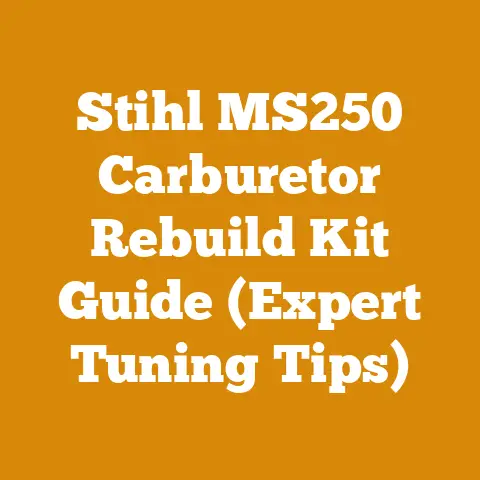Bobcat L28 Problems: Diesel Loaders for Tree Work (5 Pro Tips)
Alright, let’s dive deep into the world of Bobcat L28 diesel loaders and their role in tree work!
Bobcat L28 Problems: Diesel Loaders for Tree Work (5 Pro Tips)
Let’s be honest, when you’re shelling out good money for a piece of equipment like a Bobcat L28, you’re not just buying a machine; you’re investing in your livelihood or a serious passion project.
And one of the first things that crosses my mind, and probably yours too, is resale value.
Will this thing hold its worth?
Will it be a reliable workhorse, or a constant headache that drives down its value?
That’s why understanding the potential problems and how to tackle them is absolutely critical.
The Bobcat L28 is a popular choice for tree work due to its compact size and decent power, but like any piece of machinery, it has its quirks.
Key Takeaways:
- Proactive Maintenance is King: Preventing problems is always cheaper and less time-consuming than fixing them.
- Hydraulic Issues are Common: Understanding the hydraulic system is crucial for troubleshooting.
- Diesel Engine Care is Essential: Proper fuel and regular maintenance can extend engine life significantly.
- Undercarriage Needs Attention: Inspect and maintain the tracks or tires to avoid costly repairs.
- Operator Skill Matters: Proper operation can minimize wear and tear and prevent accidents.
Now, let’s get into the nitty-gritty of the challenges you might face with a Bobcat L28 in tree work and, more importantly, how to overcome them.
The Bobcat L28: A Solid Choice, But Not Without Its Challenges
The Bobcat L28, a compact diesel loader, is a versatile machine often favored in the tree care and firewood industries.
Its size allows it to navigate tight spaces, making it ideal for residential tree removal and firewood processing in smaller yards.
It offers enough power to lift logs, move debris, and load firewood, but it’s not without its potential pitfalls.
Why the L28 is Popular for Tree Work
- Compact Size: Easily maneuverable in confined spaces.
- Sufficient Power: Capable of lifting and moving moderately sized logs and debris.
- Versatility: Can be used with various attachments, such as grapples, buckets, and forks.
- Availability: Relatively easy to find and often available at a reasonable price point.
Potential Drawbacks to Consider
- Hydraulic System Complexity: Can be prone to leaks and failures if not properly maintained.
- Diesel Engine Issues: Requires regular maintenance to avoid fuel system and emission control problems.
- Undercarriage Wear: Tracks or tires can wear quickly, especially in abrasive conditions.
- Limited Lifting Capacity: May struggle with very large or heavy logs.
- Operator Skill Required: Proper operation is essential to avoid damage and ensure safety.
Pro Tip #1: Proactive Maintenance is Your Best Friend
I can’t stress this enough: preventative maintenance is the single most important factor in keeping your Bobcat L28 running smoothly and maintaining its resale value.
I’ve seen machines that were religiously maintained last for thousands of hours longer than those that were neglected.
Building a Solid Maintenance Schedule
- Daily Checks: Before each use, inspect fluid levels (engine oil, hydraulic oil, coolant), check for leaks, and ensure all controls are functioning correctly.
Look at the undercarriage, check for loose bolts, and make sure the tires or tracks are properly inflated or tensioned. - Weekly Checks: Grease all lubrication points.
Pay special attention to the loader arm pivots, cylinder rod ends, and any other moving parts.
This is crucial to prevent excessive wear and tear.
Inspect hoses and belts for cracks or damage. - Monthly Checks: Check and clean the air filter.
A dirty air filter restricts airflow and reduces engine performance.
Change the fuel filter.
Contaminated fuel is a major cause of diesel engine problems. - Scheduled Servicing (Every 250-500 Hours): Change the engine oil and filter.
Have the hydraulic system inspected and serviced by a qualified technician.
Check the transmission fluid and filter.
Inspect the brakes and adjust as needed.
The Importance of Proper Lubrication
Using the correct type of grease and oil is critical.
Refer to your Bobcat L28 owner’s manual for the recommended specifications.
Don’t skimp on quality; using cheap lubricants can lead to premature wear and failure.
Data Point: Studies have shown that using high-quality synthetic lubricants can reduce friction by up to 20%, resulting in improved fuel efficiency and reduced wear.
Personal Story: I once had a hydraulic pump fail prematurely because I had used the wrong type of hydraulic fluid.
It was a costly mistake that taught me a valuable lesson.
Keeping Detailed Records
Maintain a detailed maintenance log, recording all services performed, parts replaced, and any issues encountered.
This will not only help you track your maintenance schedule but also provide valuable information for troubleshooting and resale purposes.
Pro Tip #2: Taming the Hydraulic Beast
The hydraulic system is the heart of your Bobcat L28.
It powers the loader arms, bucket, and any other hydraulic attachments you might be using.
Understanding how it works and how to troubleshoot common problems is essential.
Common Hydraulic Issues and Their Solutions
- Hydraulic Leaks: This is probably the most common issue.
Check all hoses, fittings, and cylinders for leaks.
Tighten loose fittings.
Replace damaged hoses or seals. - Slow or Weak Hydraulics: This could be caused by a low hydraulic oil level, a clogged filter, or a worn pump.
Check the oil level and top up if necessary.
Replace the hydraulic filter.
Have the pump pressure tested by a qualified technician. - Overheating Hydraulics: This can be caused by a low oil level, a clogged cooler, or a faulty pump.
Check the oil level and top up if necessary.
Clean the hydraulic cooler.
Have the pump inspected. - Jerky or Erratic Movements: This could be caused by air in the system or a faulty control valve.
Bleed the hydraulic system.
Have the control valve inspected and repaired or replaced.
The Importance of Clean Hydraulic Fluid
Contaminated hydraulic fluid is a major cause of hydraulic system problems.
Dirt, debris, and water can damage the pump, valves, and cylinders.
Best Practices:
- Use the correct type of hydraulic fluid: Refer to your Bobcat L28 owner’s manual for the recommended specifications.
- Keep the fluid clean: Use a clean funnel when adding fluid.
- Change the filter regularly: Follow the manufacturer’s recommended schedule.
- Inspect the fluid regularly: Look for signs of contamination, such as cloudiness or discoloration.
Case Study: The Case of the Creeping Cylinder
I once worked with a tree service that was experiencing a creeping cylinder on their Bobcat L28.
The loader arms would slowly drift down, even when the controls were not engaged.
After a thorough inspection, we discovered that the cylinder seals were worn.
Replacing the seals solved the problem and restored the loader to its full lifting capacity.
Pro Tip #3: Diesel Engine TLC: Keeping the Heart Pumping
The diesel engine is the powerhouse of your Bobcat L28.
Proper care and maintenance are essential to ensure its longevity and reliability.
Common Diesel Engine Problems and Their Solutions
- Starting Problems: This could be caused by a low battery, a faulty starter, or a clogged fuel filter.
Check the battery voltage.
Test the starter.
Replace the fuel filter. - Poor Performance: This could be caused by a dirty air filter, a clogged fuel filter, or a faulty injector.
Check and clean the air filter.
Replace the fuel filter.
Have the injectors inspected and cleaned or replaced. - Excessive Smoke: Black smoke indicates incomplete combustion, often caused by a dirty air filter or faulty injectors.
White smoke indicates water in the fuel.
Blue smoke indicates burning oil, which could be a sign of worn piston rings or valve seals.
Address the underlying cause based on the color of the smoke. - Overheating: This could be caused by a low coolant level, a clogged radiator, or a faulty thermostat.
Check the coolant level and top up if necessary.
Clean the radiator.
Have the thermostat inspected and replaced if necessary.
The Importance of Fuel Quality
Using high-quality fuel is essential for diesel engine health.
Contaminated fuel can damage the injectors, pump, and other fuel system components.
Best Practices:
- Use fuel from a reputable source: Avoid buying fuel from questionable sources.
- Store fuel properly: Store fuel in clean, sealed containers.
- Use a fuel stabilizer: Add a fuel stabilizer to prevent fuel degradation, especially when storing fuel for extended periods.
- Drain water from the fuel tank regularly: Water can accumulate in the fuel tank and cause corrosion and other problems.
Maintaining the Emission Control System
Modern diesel engines are equipped with emission control systems, such as diesel particulate filters (DPF) and diesel exhaust fluid (DEF) systems.
These systems require regular maintenance to function properly.
Data Point: A study by the EPA found that faulty emission control systems can increase emissions by up to 10 times.
Best Practices:
- Follow the manufacturer’s recommended maintenance schedule: This includes cleaning or replacing the DPF and refilling the DEF tank.
- Use the correct type of DEF: Using the wrong type of DEF can damage the system.
- Avoid idling for extended periods: Excessive idling can clog the DPF.
Pro Tip #4: Underneath It All: Undercarriage Care
The undercarriage of your Bobcat L28, whether it’s tracks or tires, is subjected to a lot of wear and tear, especially in the demanding conditions of tree work.
Proper maintenance is crucial to avoid costly repairs.
Track Maintenance
- Track Tension: Check and adjust track tension regularly.
Too much tension can cause excessive wear on the tracks and undercarriage components.
Too little tension can cause the tracks to derail. - Track Alignment: Ensure the tracks are properly aligned.
Misalignment can cause uneven wear and reduce track life. - Track Condition: Inspect the tracks for cuts, tears, and missing or damaged pads.
Replace damaged tracks promptly. - Undercarriage Components: Inspect the rollers, idlers, and sprockets for wear and damage.
Replace worn or damaged components as needed.
Tire Maintenance
- Tire Pressure: Maintain proper tire pressure.
Underinflated tires can cause excessive wear and reduce fuel efficiency.
Overinflated tires can reduce traction and increase the risk of punctures. - Tire Condition: Inspect the tires for cuts, bulges, and uneven wear.
Replace damaged tires promptly. - Wheel Alignment: Ensure the wheels are properly aligned.
Misalignment can cause uneven wear and reduce tire life.
Operating on Different Surfaces
The type of surface you’re operating on can significantly affect the wear and tear on your undercarriage.
Best Practices:
- Avoid operating on abrasive surfaces: If possible, avoid operating on concrete or asphalt, as these surfaces can cause excessive wear on the tracks or tires.
- Use proper operating techniques: Avoid spinning the tracks or tires, as this can accelerate wear.
- Clean the undercarriage regularly: Remove mud, dirt, and debris from the undercarriage to prevent corrosion and wear.
Pro Tip #5: The Human Factor: Operator Skill and Training
Even the best-maintained machine can be damaged by improper operation.
Operator skill and training are crucial to ensure the safe and efficient operation of your Bobcat L28.
Key Operating Skills
- Smooth and Controlled Movements: Avoid jerky or abrupt movements, as these can put unnecessary stress on the machine.
- Proper Load Distribution: Distribute the load evenly in the bucket or grapple to maintain stability.
- Awareness of Surroundings: Be aware of your surroundings and avoid obstacles that could damage the machine or cause an accident.
- Understanding of Machine Limits: Know the lifting capacity of your Bobcat L28 and avoid overloading it.
- Safe Operating Procedures: Follow all safety procedures and guidelines.
The Benefits of Training
Proper training can help operators:
- Operate the machine safely and efficiently: This can reduce the risk of accidents and improve productivity.
- Minimize wear and tear on the machine: This can extend the life of the machine and reduce maintenance costs.
- Identify potential problems early: This can prevent minor issues from escalating into major repairs.
Creating a Culture of Safety
Promote a culture of safety in your workplace.
Encourage operators to report any problems or concerns they have with the machine.
Provide regular training and refresher courses.
Expert Quote: “The most important safety device on any piece of equipment is a well-trained operator.” – Safety Consultant specializing in forestry equipment.
Beyond the Basics: Advanced Troubleshooting and Repair
While preventative maintenance and basic troubleshooting can address many common problems, some issues may require more advanced knowledge and skills.
When to Call a Professional
- Complex Hydraulic Problems: If you’re unable to diagnose or repair a hydraulic problem, it’s best to call a qualified technician.
- Engine Problems: Engine problems can be complex and require specialized tools and knowledge.
- Electrical Problems: Electrical problems can be difficult to diagnose and can be dangerous if not handled properly.
- Major Undercarriage Repairs: Major undercarriage repairs, such as replacing rollers or idlers, require specialized equipment and expertise.
Finding a Reputable Technician
- Ask for recommendations: Ask other tree care professionals or equipment dealers for recommendations.
- Check references: Check the technician’s references and ask about their experience with Bobcat L28 loaders.
- Get a written estimate: Get a written estimate before authorizing any repairs.
- Ensure they are certified: Ensure the technician is certified and has the necessary qualifications to perform the repairs.
The Bottom Line: Investing in Longevity and Value
Owning a Bobcat L28 for tree work can be a valuable asset, but it’s crucial to understand the potential problems and how to address them.
By following these five pro tips, you can keep your machine running smoothly, minimize downtime, and maintain its resale value.
Actionable Steps:
And remember, a well-maintained machine is not only more reliable but also holds its value better when it’s time to upgrade.
Good luck, and happy tree work!






